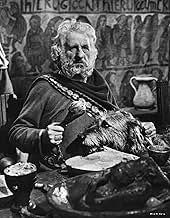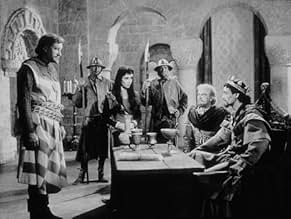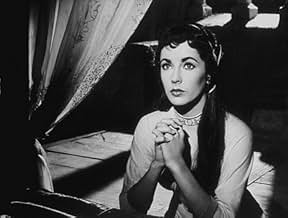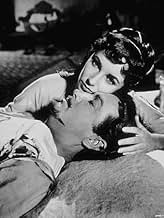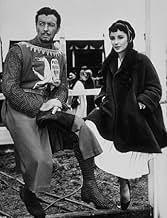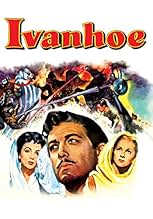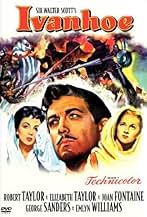ÉVALUATION IMDb
6,7/10
11 k
MA NOTE
Un chevalier tente de libérer le Roi Richard emprisonné pour lui rendre son trône.Un chevalier tente de libérer le Roi Richard emprisonné pour lui rendre son trône.Un chevalier tente de libérer le Roi Richard emprisonné pour lui rendre son trône.
- Nommé pour 3 oscars
- 2 victoires et 9 nominations au total
Francis De Wolff
- Front De Boeuf
- (as Francis DeWolff)
Avis en vedette
This splendid version of Sir Walter Scott's classic epic tale starts in 12th century, when Saxon Knight Wilfred of Ivanhoe(Robert Taylor), a suitable noble, having fought for Richard the Lionhearted(Norman Wooland) during the Crusades, goes back to England. He aware king Richard has been taken prisoner and gets a letter written, telling the following : 'To the people of England . I am here held captive by Leopold of Austria. My brother, prince John has knowledge of it, yet he has denied my ransom. One hundred and fifty thousand marks of silver. I fear he does conspire with certain Norman knights to seize my throne. People of England, speed my deliverance. Your kingdom is at stake'. In order to regain his freedom, Ivanhoe attended by a likable squire(Emilyn Williams) confronts Prince John(Guy Rolfe) and his lieutenants(in this case George Sanders and Robert Douglas)and he's also drawn to Jewish healer Rebecca(Elizabeth Taylor), Isaac(Felix Aylmer)of York's daughter. Meanwhile, Ivanhoe woo maidens, as his childhood sweetheart, Saxon heiress Rowena(Joan Fontaine).Prince John, now John Lackland will stop at nothing to assume the throne. Ivanhoe join forces with Robin Hood and his Merry man who attack the stronghold.
This enjoyable film displays romance, chivalry, knighthood, daring jousting and lots of action with spectacular castle attack. This one proved notable hit as well as the others two Robert Taylor's forays into English history, 'Quentin Durward and Knights of the Round table', produced and directed by similar crew, Pandro S Berman and Richard Thorpe. The film packs a glamorous and luminous cinematography by Freddie Young and evocative musical score by Miklos Rozsa. The picture is excellently handled by Richard Thorpe.
The film is partially based on true events. Although Ivanhoe didn't exist, John Lackland was king of England from 1199 to 1216. Few monarchs have been subject to such appalling publicity as John, Although by no means lovable, he was an able administrator and spent more time in England than his predecessor and elder brother Richard I but he was jailed by Leopold of Austria, returning from Crusades. Besides appears Robin Hood, also known Robin O'Locksley and the Earl of Huntingdom, is probably and sadly a creation of romantic imaginations. If Robin Hood did exist, it's almost certain that he was not a Saxon , though his enemies may well have been the Norman sheriff of Nottinghan and Prince and later king John Lackland.
This enjoyable film displays romance, chivalry, knighthood, daring jousting and lots of action with spectacular castle attack. This one proved notable hit as well as the others two Robert Taylor's forays into English history, 'Quentin Durward and Knights of the Round table', produced and directed by similar crew, Pandro S Berman and Richard Thorpe. The film packs a glamorous and luminous cinematography by Freddie Young and evocative musical score by Miklos Rozsa. The picture is excellently handled by Richard Thorpe.
The film is partially based on true events. Although Ivanhoe didn't exist, John Lackland was king of England from 1199 to 1216. Few monarchs have been subject to such appalling publicity as John, Although by no means lovable, he was an able administrator and spent more time in England than his predecessor and elder brother Richard I but he was jailed by Leopold of Austria, returning from Crusades. Besides appears Robin Hood, also known Robin O'Locksley and the Earl of Huntingdom, is probably and sadly a creation of romantic imaginations. If Robin Hood did exist, it's almost certain that he was not a Saxon , though his enemies may well have been the Norman sheriff of Nottinghan and Prince and later king John Lackland.
The difficulty with bringing a piece of revered literature to the big screen has more to do with pleasing the fans of the work than in making a pleasing movie. Those who hold Walter Scott's classic "Ivanhoe" in high esteem will deem any adaptation to a largely visual medium unworthy no matter how much care and devotion are given to visualizing the original source.
This version of "Ivanhoe" holds up well and remains one of the more realistic films dealing with the myth, legends, and pomp of the High Middle Ages. The pictorial representation of Judaism at a time of wide-spread persecution of that religion throughout Europe by Christians who continually used the Jews as scapegoats was noble indeed for 1952, the height of the McCarthy witch hunts. The audience of the day undoubtedly overlooked this point when Rebecca is accused of witchcraft in order to insure conformity and stifle opposition to Prince John's tyrannical rule of England in King Richard's absence.
From a historical perspective, this film is about as accurate as any of the numerous Robin Hood tales prevalent at the time in the movies and on TV. Ivanhoe's father is correct when he remarks that Richard would be no better than John as far as the Saxons were concerned. Both Richard and John were ineffectual rulers. Prince John (later King John) has received a bad press as a result of the lionization of Richard the Lionheart. At least John stayed home and attempted to rule England; whereas, Richard was always traipsing about Europe and the Near East on a Crusade or leading his knights in battle mainly for personal gain. His ransom as a result of falling into the hands of the Germans was costly for his realm. Neither Richard or John was the skilled administrator their father, Henry II, proved to be, one of England's greatest monarchs. Neither inherited the diplomatic skills of their mother, Eleanor of Aquitaine, one of the great women leaders in western civilization.
The division between the Saxons and Normans as a result of the Norman invasion of 1066 is at the crux of the story, Ivanhoe being Saxon, the royal family being Norman, descended from William the Conqueror. Nothing is said about those who lived on the British Isles before either the Saxons or the Normans, the Celts first, then the conquering Romans.
A highlight of "Ivanhoe" is the jousting tournament, leading to rivalry between Ivanhoe (Robert Taylor) and Sir Brian de Bois-Guilbert (George Sanders), a rivalry that extends to winning the hand and heart of Rebecca. The alluring nineteen-year-old Elizabeth Taylor who portrays Rebecca is at the peak of her beauty and loveliness. George Sanders and Robert Taylor were much older than Elizabeth at the time. Taylor was uncomfortable making love, even on celluloid, to one so young, especially since he recalled her as a child in the early days of his movie career.
The brilliant Technicolor cinematography is bewitching even by today's standards. Adding to the eye-catching color are the action scenes, especially toward the end of the movie. The besieging of the castle is directed with élan by Richard Thorpe, who learned his trade well from directing action packed B films.
The acting is top notch throughout with Guy Rolfe as the loathsome Prince John stealing every scene he's in. The weakest is Emlyn Williams who plays Wamba (a chattel who becomes Ivanhoe's Squire). Wamba apparently is supposed to supply comic relief and is given some good lines by the writers, but Williams tends to overplay the part to the extent that at times the character becomes an obnoxious loudmouth.
This version of "Ivanhoe" holds up well and remains one of the more realistic films dealing with the myth, legends, and pomp of the High Middle Ages. The pictorial representation of Judaism at a time of wide-spread persecution of that religion throughout Europe by Christians who continually used the Jews as scapegoats was noble indeed for 1952, the height of the McCarthy witch hunts. The audience of the day undoubtedly overlooked this point when Rebecca is accused of witchcraft in order to insure conformity and stifle opposition to Prince John's tyrannical rule of England in King Richard's absence.
From a historical perspective, this film is about as accurate as any of the numerous Robin Hood tales prevalent at the time in the movies and on TV. Ivanhoe's father is correct when he remarks that Richard would be no better than John as far as the Saxons were concerned. Both Richard and John were ineffectual rulers. Prince John (later King John) has received a bad press as a result of the lionization of Richard the Lionheart. At least John stayed home and attempted to rule England; whereas, Richard was always traipsing about Europe and the Near East on a Crusade or leading his knights in battle mainly for personal gain. His ransom as a result of falling into the hands of the Germans was costly for his realm. Neither Richard or John was the skilled administrator their father, Henry II, proved to be, one of England's greatest monarchs. Neither inherited the diplomatic skills of their mother, Eleanor of Aquitaine, one of the great women leaders in western civilization.
The division between the Saxons and Normans as a result of the Norman invasion of 1066 is at the crux of the story, Ivanhoe being Saxon, the royal family being Norman, descended from William the Conqueror. Nothing is said about those who lived on the British Isles before either the Saxons or the Normans, the Celts first, then the conquering Romans.
A highlight of "Ivanhoe" is the jousting tournament, leading to rivalry between Ivanhoe (Robert Taylor) and Sir Brian de Bois-Guilbert (George Sanders), a rivalry that extends to winning the hand and heart of Rebecca. The alluring nineteen-year-old Elizabeth Taylor who portrays Rebecca is at the peak of her beauty and loveliness. George Sanders and Robert Taylor were much older than Elizabeth at the time. Taylor was uncomfortable making love, even on celluloid, to one so young, especially since he recalled her as a child in the early days of his movie career.
The brilliant Technicolor cinematography is bewitching even by today's standards. Adding to the eye-catching color are the action scenes, especially toward the end of the movie. The besieging of the castle is directed with élan by Richard Thorpe, who learned his trade well from directing action packed B films.
The acting is top notch throughout with Guy Rolfe as the loathsome Prince John stealing every scene he's in. The weakest is Emlyn Williams who plays Wamba (a chattel who becomes Ivanhoe's Squire). Wamba apparently is supposed to supply comic relief and is given some good lines by the writers, but Williams tends to overplay the part to the extent that at times the character becomes an obnoxious loudmouth.
In his return from the crusades king Richard of England is captured and held for ransom by Austrian king Leopold. His loyal knight Wifred of Ivanhoe tries to collect the amount for his liberation but Prince John (Richard's brother) sits now in the throne and will do anything to stay there with the aid of some Normand knights.
This is a real good action and adventure medieval film with knights, maidens, castles, tournaments, battles, duels and else. Richard Thorpe direction is excellent (perhaps his best work ever); you'll find also good color photography, well made settings and an interesting plot. Costumes and armours -though perhaps too "hollywoodish" perfect- are also a plus.
Robert Taylor (Ivanhoe) was in his peak and does well as the reliable and faithful knight who fights for his captive king. George Sanders is very well casted as Brian de Bois Gilbert the Templar warrior-monk that would give up his honor for the love of the Jewish maiden Rebbeca (Elizabeth Taylor) but will rather see her death when he is rejected. Joan Fontaine is Lady Rowena Ivanhoe's bride. The rest of the cast includes some all time favourites as Felix Aylmer (Rebbeca's father), Finlay Currie (Cedric the Saxon), Robert Douglas (as Sanders's sidekick Sir Hugh de Bracy) and in a typical role for him Guy Rolfe as the treacherous and ambitious Prince John (this guy was born to play villains).
The tournament in which Ivanhoe challenges the five top Saxon knights and the assault on Front de Beuf's castle by Robin of Locksley and his men are very well achieved action scenes and even more if you consider it was the early 50's. And the final duel between Taylor and Sanders is a great climax for the film (notice they chose war axe and iron ball and chain instead of the usual swords).
A most enjoyable film in its genre.
This is a real good action and adventure medieval film with knights, maidens, castles, tournaments, battles, duels and else. Richard Thorpe direction is excellent (perhaps his best work ever); you'll find also good color photography, well made settings and an interesting plot. Costumes and armours -though perhaps too "hollywoodish" perfect- are also a plus.
Robert Taylor (Ivanhoe) was in his peak and does well as the reliable and faithful knight who fights for his captive king. George Sanders is very well casted as Brian de Bois Gilbert the Templar warrior-monk that would give up his honor for the love of the Jewish maiden Rebbeca (Elizabeth Taylor) but will rather see her death when he is rejected. Joan Fontaine is Lady Rowena Ivanhoe's bride. The rest of the cast includes some all time favourites as Felix Aylmer (Rebbeca's father), Finlay Currie (Cedric the Saxon), Robert Douglas (as Sanders's sidekick Sir Hugh de Bracy) and in a typical role for him Guy Rolfe as the treacherous and ambitious Prince John (this guy was born to play villains).
The tournament in which Ivanhoe challenges the five top Saxon knights and the assault on Front de Beuf's castle by Robin of Locksley and his men are very well achieved action scenes and even more if you consider it was the early 50's. And the final duel between Taylor and Sanders is a great climax for the film (notice they chose war axe and iron ball and chain instead of the usual swords).
A most enjoyable film in its genre.
I can't comment on the film as an adaption but I did find that it was quite entertaining standing alone. Some have criticized Robert Taylor for being too stiff, but I found him to be suitably formal and chivalrous. Elizabeth Taylor and Joan Fontaine both provided ample glamour and grace to their roles. They are also both very photogenic to say the least. The performance of George Sanders intrigued me the most. Though a villain, he actually became more sympathetic to me as the movie progressed. The relationship of the four major characters was what kept me interested. Although I am sure it took careful planning and execution (and a lot of extras) to stage the fight scenes, I actually thought they were quite perfunctory. Solid if not spectacular, 7/10.
"Ivanhoe," filmed in bright techicolor was nominated for best picture in 1952.
Miklos Rosza again provides us with a major musical score. I always felt that his scores, so rich in textures, would be a prelude to his Oscar-winning score in "Ben-Hur." (1959)
The film deals with the ongoing fight between the Anglo-Saxons and Normans, the latter having ruled England since the infamous Battle of Hastings in 1066. While fighting in the crusades, Richard the Lionhearted has been kidnapped and held captive in Austria. This has been done with the help of the Austrian emperor Leopold and Prince John, Richard's evil brother, who assumes the throne in his brother's absence.
I laughed at the beginning of the film when Robert Taylor, who plays Ivanhoe, loyal to Richard, asks someone for a translation as he doesn't read Austrian. Didn't they mean German? While it is true that Germany did not become a unified country until 1871 following the Franco-Prussian war, the dialect spoken in the entire region was German.
Taylor rallies to the aid of his people. Hurt, he is given refuge by the Jewess Rebecca, played with warmth and skill by Elizabeth Taylor. Her father, Isaac the Jew, played by the always serious Felix Aylmer, promises to help pay the ransom for Richard so that his people can have religious toleration in England. Naturally, Rebecca loves Ivanhoe but so does Lady Rowena played by a much reserved Joan Fontaine. Her guardian, the father of Ivanhoe in the film, is portrayed by Finlay Currie, who played in numerous bible films.
The Technicolor and cinematography are breathtaking in the film.
A story of love and devotion, especially that of George Sanders, who sacrifices all for Rebecca.
Miklos Rosza again provides us with a major musical score. I always felt that his scores, so rich in textures, would be a prelude to his Oscar-winning score in "Ben-Hur." (1959)
The film deals with the ongoing fight between the Anglo-Saxons and Normans, the latter having ruled England since the infamous Battle of Hastings in 1066. While fighting in the crusades, Richard the Lionhearted has been kidnapped and held captive in Austria. This has been done with the help of the Austrian emperor Leopold and Prince John, Richard's evil brother, who assumes the throne in his brother's absence.
I laughed at the beginning of the film when Robert Taylor, who plays Ivanhoe, loyal to Richard, asks someone for a translation as he doesn't read Austrian. Didn't they mean German? While it is true that Germany did not become a unified country until 1871 following the Franco-Prussian war, the dialect spoken in the entire region was German.
Taylor rallies to the aid of his people. Hurt, he is given refuge by the Jewess Rebecca, played with warmth and skill by Elizabeth Taylor. Her father, Isaac the Jew, played by the always serious Felix Aylmer, promises to help pay the ransom for Richard so that his people can have religious toleration in England. Naturally, Rebecca loves Ivanhoe but so does Lady Rowena played by a much reserved Joan Fontaine. Her guardian, the father of Ivanhoe in the film, is portrayed by Finlay Currie, who played in numerous bible films.
The Technicolor and cinematography are breathtaking in the film.
A story of love and devotion, especially that of George Sanders, who sacrifices all for Rebecca.
Le saviez-vous
- AnecdotesAt the beginning, Sir Wilfred of Ivanhoe is looking for King Richard I by singing until he finds the King. This is historically accurate, with the exception that the singer was a minstrel called Blondel. When Leopold of Austria captured King Richard I, Blondel went around to all of the castles singing King Richard's favorite song. (One story had it that King Richard actually co-wrote the song.) When he heard King Richard join in the chorus, he went home and told the Normans where King Richard was.
- GaffesCharacters are shown eating turkey during the feast in Ivanhoe's father's hall. Turkeys are indigenous to North America and were not known in England in the 12th century.
- Citations
Minor Role: Milord, there is a stranger at your gate who begs shelter. He is a Jew who calls himself Isaac of York.
Sir Brian de Bois-Guilbert: I share no roof with an infidel.
Wamba: Why not, sir knight? For every Jew you show me who's not a Christian, l'll show you a Christian who's not a Christian.
- ConnexionsEdited into Hollywood: The Dream Factory (1972)
- Bandes originalesThe Song of Ivanhoe
(1952) (uncredited)
Music by Miklós Rózsa
Lyrics by Marguerite Roberts
Sung by Robert Taylor and Norman Wooland
Meilleurs choix
Connectez-vous pour évaluer et surveiller les recommandations personnalisées
- How long is Ivanhoe?Propulsé par Alexa
Détails
- Date de sortie
- Pays d’origine
- Langue
- Aussi connu sous le nom de
- Ivanhoe
- Lieux de tournage
- MGM British Studios, Borehamwood, Hertfordshire, Angleterre, Royaume-Uni(studio: interiors and exteriors: Torquilstone Castle and lists at Ashby La Zouche)
- société de production
- Consultez plus de crédits d'entreprise sur IMDbPro
Box-office
- Budget
- 3 842 000 $ US (estimation)
- Durée1 heure 46 minutes
- Rapport de forme
- 1.37 : 1
Contribuer à cette page
Suggérer une modification ou ajouter du contenu manquant



